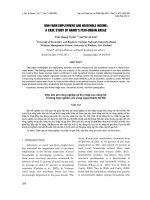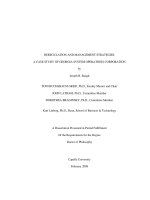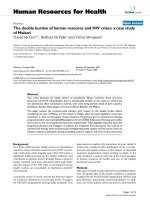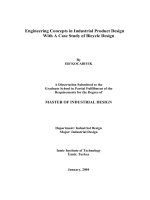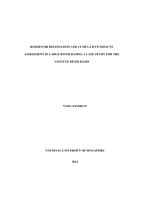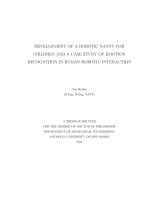Innovation and productivity in small and medium enterprises, a case study of vietnam
Bạn đang xem bản rút gọn của tài liệu. Xem và tải ngay bản đầy đủ của tài liệu tại đây (563.09 KB, 82 trang )
UNIVERSITY OF ECONOMICS
INSTITUTE OF SOCIAL STUDIES
HO CHI MINH CITY
THE HAGUE
VIETNAM
THE NETHERLANDS
VIETNAM – THE NETHERLANDS
PROGRAMME FOR M.A IN DEVELOPMENT ECONOMICS
INNOVATION AND PRODUCTIVITY IN
SMALL AND MEDIUM ENTERPRISES:
A CASE STUDY OF VIETNAM
By
PHAM DO TUONG VY
MASTER OF ART IN DEVELOPMENT ECONOMICS
HCMC, NOVEMBER 2016
University of Economics
International Institute of Social Study
Ho Chi Minh City
The Hague
Vietnam
The Netherlands
VIETNAM – THE NETHERLANDS
PROGRAMME FOR M.A IN DEVELOPMENT ECONOMICS
INNOVATION AND PRODUCTIVITY IN
SMALL AND MEDIUM ENTERPRISES:
A CASE STUDY OF VIETNAM
by Pham Do Tuong Vy
A Thesis Submitted in Partial Fulfilment of the Requirements for
the Degree of
Master of Art in
Development Economics
Academic Supervisor: Dr. Vo Hong Duc
HCMC, NOVEMBER 2016
DECLARATION
I hereby declare that this thesis entitled “Innovation and Productivity in
Small and Medium sized Enterprises: A case study of Vietnam”, which is written
and submitted by me in accordance with the requirement for the degree of Master of
Art in Development Economics to the Vietnam – The Netherlands Programme. This
is my original work and all sources of knowledge carried in this thesis have been duly
acknowledged.
HCMC, November 2016
PHẠM ĐỖ TƯỜNG VY
ACKNOWLEDGEMENT
I would like to take this opportunity to express my deepest gratitude for the
help, support and encouragement of the following people, who have contributed to
the completion of this thesis in their very own ways.
Above all, I would like to express my immeasurable appreciation to my
supervisor – Dr. Võ Hồng Đức for his precious time, support and advices to make
this thesis completed.
Furthermore, I would like to send my great thanks to all the lecturers and staffs
at the Vietnam – The Netherlands Programme for their knowledge and supports
during my time joining in the program. In specific, I am extremely grateful to Dr.
Phạm Khánh Nam and Dr. Trương Đăng Thụy for their valuable guidance and
support in the courses and thesis writing process.
To all of my friends in Class 21 and my colleagues at TPF, I could never
thankful enough for your encouragement and support until the very end of this thesis.
Last but not least, my deepest thanks and love to my parents, who have always
been beside me. Without their unconditional love, none of this would have been
possible.
ABBREVIATION
2SLS
Two Stage Least Squares.
CDM
Crépon, Duguet and Mairesse.
FE
Fixed Effect.
GMM
Generalized Method of Moments.
GSO
General Statistic Office.
IV
Instrument Variables.
LP
Levinsohn and Petrin.
OLS
Ordinary Least Squares.
OP
Olley and Parker.
R&D
Research and Development.
SMEs
Small and Medium-sized Enterprises.
TFP
Total Factor Productivity.
ABSTRACT
The majority of enterprises in Vietnam is categorized as small and medium
sized (SMEs) firms which play an important role to the sustainable growth of the
Vietnamese economy. As such, improving the productivity of the SMEs is essentially
needed and this request becomes a crucial mission for the governments. It is generally
accepted that innovation and technology improvement are key drivers of productivity
(Bartelsman & Doms, 2000). However, they have not been well-acknowledged by
the SMEs in Vietnam even though their huge contribution to firm’s productivity is
unarguable.
This study aims to examine the relationship between innovation and
productivity in the Small and Medium-sized Enterprises (SMEs) in Vietnam. To
establish and quantify this relationship, this study employs the two-stage process: (i)
the estimation of total factor productivity for each firm; and (ii) a determination of an
innovation – productivity relationship. In the first stage, total factor productivity is
estimated based on production function using the input and output approach.
However, firms might adjust their input level according to expected productivity
shock. As such, a potential endogeneity caused by possible relationship between input
decision and productivity shocks (unobserved productivity shock) might exist. To
deal with this problem of endogeneity, an approach developed by Levinsohn and
Petrin is applied to estimate firm’s total productivity. In the second stage, the systemGMM approach is adopted to examine the relationship between innovation and
productivity.
An unbalanced panel dataset from five Small and Medium-sized Enterprises
surveys from 2005 to 2013 is used in this study. Findings from this study indicate
that, in the context of Vietnam, when innovation is measured as innovation
expenditure intensity and high-quality labor share in total firm’s labor force,
innovation activities provide positive and significant impact on firm’s productivity.
In addition, past value of firm’s productivity also has significant relationship with its
current level. This finding implies that higher (lower) level of current productivity
could lead to higher (lower) level of productivity in the future. The study also
provides empirical evidence to confirm that larger firms might perform better than
the relatively smaller firms. In contrast, capital structure provides negative impact on
firm’s productivity. However, this study fails to provide any evidence to support the
view that longevity of firm does provide significant impact on productivity of firms.
Key words:
Vietnam SMEs; Total factor productivity; Productivity Shock;
Innovation, GMM.
TABLE OF CONTENTS
CHAPTER 1 ..............................................................................................................1
INTRODUCTION .....................................................................................................1
1.1.
Problem statement .........................................................................................1
1.2.
Research objectives .......................................................................................2
1.3.
Research questions ........................................................................................2
1.4.
Research motivations .....................................................................................2
1.5.
Research scope and data ................................................................................3
1.6.
The structure of this study .............................................................................3
CHAPTER 2 ..............................................................................................................5
LITERATURE REVIEW .........................................................................................5
2.1. Schumpeter Theory of Innovation – How does Innovation play its role in
economic development? ..........................................................................................5
2.2.
Productivity: concept and measurements ......................................................7
2.1.1.
Concept ...................................................................................................7
2.1.2.
Measurements .........................................................................................7
2.1.3.
General productivity determinants .......................................................12
2.3.
Innovation: concept and measurements.......................................................16
2.1.4.
Concept .................................................................................................16
2.1.5.
Measurements .......................................................................................17
2.4. How has the relationship between innovation and firms’ performance been
analysed in the literature? ......................................................................................18
CHAPTER 3 ............................................................................................................23
RESEARCH METHODOLOGY ..........................................................................23
3.1.
An overview of Vietnamese Small and Medium-sized Enterprises ............23
3.1.1.
Statistic overview ..................................................................................23
3.1.2.
Difficulties ............................................................................................26
3.2.
Methodology ................................................................................................27
3.1.3.
Conceptual framework ..........................................................................27
3.1.4.
Model identification ..............................................................................29
3.3.
Research hypotheses and concept measurements........................................34
3.1.5.
Research hypotheses .............................................................................34
3.1.6.
Concept and variable measurements ....................................................34
3.4.
Data sources .................................................................................................36
CHAPTER 4 ............................................................................................................39
EMPIRICAL RESULTS ........................................................................................39
4.1.
Total Factor Productivity of Vietnamese SMEs ..........................................39
4.1.1.
Data descriptions...................................................................................39
4.1.2. Total factor productivity from production function estimation of
Vietnamese SMEs ..............................................................................................42
4.2.
Innovation – Firm’s productivity relationship .............................................45
4.1.3.
Data descriptions...................................................................................45
4.1.4. The relationship between innovation expenditure intensity and firm’s
productivity ........................................................................................................46
4.1.5. The relationship between high-quality labor share in total firm’s labor
force and their productivity ................................................................................49
CHAPTER 5 ............................................................................................................52
CONCLUSION AND POLICY IMPLICATION ................................................52
5.1.
Conclusion remarks .....................................................................................52
5.2.
Policy implications ......................................................................................54
5.3.
Limitation and potential future research ......................................................54
REFERENCES ........................................................................................................56
APPENDIX 1: Empirical studies on general productivity determinants ..........62
APPENDIX 2: Empirical studies on relationship between innovation and
firm’s performance .................................................................................................65
APPENDIX 3: Durbin – Wu Hausman test for endogeneity ..............................69
APPENDIX 4: Durbin – Wu Hausman test for endogeneity ..............................71
LIST OF TABLES AND FIGURES
Table 3.1:
Classification of SMEs in Vietnam
Table 3.2:
Concepts and measurements of variables used in the study
Table 3.3:
Number of observation in selected industries in dataset
Table 3.4:
Number of observation after filtering
Table 3.5:
Number of observation after filtering in stage 2
Table 4.1:
Descriptive statistics of production function variables
Table 4.2:
Comparison of OLS, Fixed Effect and LP estimators in Foods, Woods
and Rubber and Plastics
Table 4.3:
Comparison of OLS, Fixed Effect and LP estimators in Non-metallic
mineral, Fabricated metal and Furniture
Table 4.4:
Descriptive statistics of TFP and its determinants
Table 4.5:
Regression results of innovation expenditure intensity and firm’s
productivity
Table 4.6:
Regression results of high-quality labor share����������������������������������������������������������������������������������������������������������������������������������������������������������������������������������������������������������������������������������������������������������������������������������������������������������������������������������������������������������������������������������������������������������������������������������������������������������������������������������������������������������������������������������������������������������������������������������������������������������������������������������������������������������������������������������������������������������������������������������������������������������������������������������������������������������������������������������������������������������������������������������������������������������������������������������������������������������������������������������������������������������������������������������������������������������������������������������������������������������������������������������������������������������������������������������������������������������������������������������������������������������������������������������������������������������������������������������������������������������������������������������������������������������������������������������������������������������������������������������������������������������������������������������������������������������������������������������������������������������������������������������������������������������������������������������������������������������������������������������������������������������������������������������������������������������������������������������������������������������������������������������������������������������������������������������������������������������������������������������������������������������������������������������������������������������������������������������������������������������������������������������������������������������������������������������������������������������������������������������������������������������������������������������������������������������������������������������������������������������������������������������������������������������������������������������������������������������������������������������������������������������������������������������������������������������������������������������������������������������������������������������������������������������������������������������������������������������������������������������������������������������������������������������������������������������������������������������������������������������������������������������������������������������������������������������������������������������������������������������������������������������������������������������������������������������������������������������������������������������������������������������������������������������������������������������������������������������������������������������������������������������������������������������������������������������������������������������������������������������������������������������������������������������������������������������������������������������������������������������������������������������������������������������������������������������������������������������������������������������������������������������������������������������������������������������������������������������������������������������������������������������������������������������������������������������������������������������������������������������������������������������������������������������������������������������������������������������������������������������������������������������������������������������������������������������������������������������������������������������������������������������������������������������������������������������������������������������������������������������������������������������������������������������������������������������������������������������������������������������������������������������������������������������������������������������������������������������������������������������������������������������������������������������������������������������������������������������������������������������������������������������������������������������������������������������������������������������������������������������������������������������������������������������������������������������������������������������������������������������������������������������������������������������������������������������������������������������������������������������������������������������������������������������������������������������������������������������������������������������������������������������������������������������������������������������������������������������������������������������������������������������������������������������������������������������������������������������������������������������������������������������������������������������������������������������������������������������������������������������������������������������������������������������������������������������������������������������������������������������������������������������������������������������������������������������������������������������������������������������������������������������������������������������������������������������������������������������������������������������������������������������������������������������������������������������������������������������������������������������������������������������������������������������������������������������������������������������������������������������������������������������������������������������������������������������������������������������������������������������������������������������������������������������������������������������������������������������������������������������������������������������������������������������������������������������������������������������������������������������������������������������������������������������������������������������������������������������������������������������������������������������������������������������������������������������������������������������������������������������������������������������������������������������������������������������������������������������������������������������������������������������������������������������������������������������������������������������������������������������������������������������������������������������������������������������������������������������������������������������������������������������������������������������������������������������������������������������������������������������������������������������������������������������������������������������������������������������������������������������������������������������������������������������������������������������������������������������������������������������������������������������������������������������������������������������������������������������������������������������������������������������������������������������������������������������������������������������������������������������������������������������������������������������������������������������������������������������������������������������������������������������������������������������������������������������������������������������������������������������������������������������������������������������������������������������������������������������������������������������������������������������������������������������������������������������������������������������������������������������������������������������������������������������������������������������������������������������������������������������������������������������������������������������������������������������������������������������������������������������������������������������������������������������������������������������������������������������������������������������������������������������������������������������������������������������������������������������������������������������������������������������������������������������������������������������������������������������������������������������������������������������������������������������������������������������������������������������������������������������������������������������������������������������������������������������������������������������������������������������������������������������������������������������������������������������������������������������������������������������������������������������������������������������������������������������������������������������������������������������������������������������������������������������������������������������������������������������������������������������������������������������������������������������������������������������������������������������������������������������������������������������������������������������������������������������������������������������������������������������������������������������������������������������������������������������������������������������������������������������������������������������������������������������������������������������������������������������������������������������������������������������������������������������������������������������������������������������������������������������������������������������������������������������������������������������������������������������������������������������������������������������������������������������������������������������������������������������������������������������������������������������������������������������������������������������������������������������������������������������������������������������������������������������������������������������������������������������������������������������������������������������������������������������������������������������������������������������������������������������������������������������������������������������������������������������������������������������������������������������������������������������������������������������������������������������������������������������������������������������������������������������������������������������������������������������������������������������������������������������������������������������������������������������������������������������������������������������������������������������������������������������������������������������������������������������������������������������������������������������������������������������������������������������������������������������������������������������������������������������������������������������������������������������������������������������������������������������������������������������������������������������������������������������������������������������������������������������������������������������������������������������������������������������������������������������������������������������������������������������������������������������������������������������������������������������������������������������������������������������������������������������������������������������������������������������������������������������������������������������������������������������������������������������������������������������������������������������������������������������������������������������������������������������������������������������������������������������������������������������������������������������������������������������������������������������������������������������������������������������������������������������������������������������������������������������������������������������������������������������������������������������������������������������������������������������������������������������������������������������������������������������������������������������������������������������������������������������������������������������������������������������������������������������������������������������������������������������������������������������������������������������������������������������������������������������������������������������������������������������������������������������������������������������������������������������������������������������������������������������������������������������������������������������������������������������������������������������������������������������������������������������������������������������������������������������������������������������������������������������������������������������������������������������������������������������������������������������������������������������������������������������������������������������������������������������������������������������������������������������������������������������������������������������������������������������������������������������������������������������������������������������������������������������������������������������������������������������������������������������������������������������������������������������������������������������������������������������������������������������������������������������������������������������������������������������������������������������������������������������������������������������������������������������������������������������������������������������������������������������������������������������������������������������������������������������������������������������������������������������������������������������������������������������������������������������������������������������������������������������������������������������������������������������������������������������������������������������������������������������������������������������������������������������������������������������������������������������������������������������������������������������������������������������������������������������������������������������������������������������������������������������������������������������������������������������������������������������������������������������������������������������������������������������������������������������������������������������������������������������������������������������������������������������������������������������������������������������������������������������������������������������������������������������������������������������������������������������������������������������������������������������������������������������������������������������������������������������������������������������������������������������������������������������������������������������������������������������������������������������������������������������������������������������������������������������������������������������������������������������������������������������������������������������������������������������������������������������������������������������������������������������������������������������������������������������������������������������������������������������������������������������������������������������������������������������������������������������������������������������������������������������������������������������������������������������������������������������������������������������������������������������������������������������������������������������������������������������������������������������������������������������������������������������������������������������������������������������������������������������������������������������������������������������������������������������������������������������������������������������������������������������������������������������������������������������������������������������������������������������������������������������������������������������������������������������������������������������������������������������������������������������������������������������������������������������������������������������������������������������������������������������������������������������������������������������������������������������������������������������������������������������������������������������������������������������������������������������������������������������������������������������������������������������������������������������������������������������������������������������������������������������������������������������������������������������������������������������������������������������������������������������������������������������������������������������������������������������������������������������������������������������������������������������������������������������������������������������������������������������������������������������������������������������������������������������������������������������������������������������������������������������������������������������������������������������������������������������������������������������������������������������������������������������������������������������������������������������������������������������������������������������������������������������������������������������������������������������������������������������������������������������������������������������������������������������������������������������������������������������������������������������������������������������������������������������������������������������������������������������������������������������������������������������������������������������������������������������������������������������������������������������������������������������������������������������������������������������������������������������������������������������������������������������������������������������������������������������������������������������������������������������������������������������������������������������������������������������������������������������������������������������������������������������������������������������������������������������������������������������������������������������������������������������������������������������������������������������������������������������������������������������������������������������������������������������������������������������������������������������������������������������������������������������������������������������������������������������������������������������������������������������������������������������������������������������������������������������������������������������������������������������������������������������������������������������������������������������������������������������������������������������������������������������������������������������������������������������������������������������������������������������������������������������������������������������������������������������������������������������������������������������������������������������������������������������������������������������������������������������������������������������������������������������������������������������������������������������������������������������������������������������������������������������������������������������������������������������������������������������������������������������������������������������������������������������������������������������������������������������������������������������������������������������������������������������������������������������������������������������������������������������������������������������������������������������������������������������������������������������������������������������������������������������������������������������������������������������������������������������������������������������������������������������������������������������������������������������������������������������������������������������������������������������������������������������������������������������������������������������������������������������������������������������������������������������������������������������������������������������������������������������������������������������������������������������������������������������������������������������������������������������������������������������������������������������������������������������������������������������������������������������������������������������������������������������������������������������������������������������������������������������������������������������������������������������������������������������������������������������������������������������������������������������������������������������������������������������������������������������������������������������������������������������������������������������������������������������������������������������������������������������������������������������������������������������������������������������������������������������������������������������������������������������������������������������������������������������������������������������������������������������������������������������������������������������������������������������������������������������������������������������������������������������������������������������������������������������������������������������������������������������������������������������������������������������������������������������������������������������������������������������������������������������������������������������������������������������������������������������������������������������������������������������������������������������������������������������������������������������������������������������������������������������������������������������������������������������������������������������������������������������������������������������������������������������������������������������������������������������������������������������������������������������������������������������������������������������������������������������������������������������������������������������������������������������������������������������������������������������������������������������������������������������������������������������������������������������������������������������������������������������������������������������������������������������������������������������������������������������������������������������������������������������������������������������������������������������������������������������������������������������������������������������������������������������������������������������������������������������������������������������������������������������������������������������������������������������������������������������������������������������������������������������������������������������������������������������������������������������������������������������������������������������������������������������������������������������������������������������������������������������������������������������������������������������������������������������������������������������������������������������������������������������������������������������������������������������������������������������������������������������������������������������������������������������������������������������������������������������������������������������������������������������������������������������������������������������������������������������������������������������������������������������������������������������������������������������������������������������������������������������������������������������������������������������������������������������������������������������������������������������������������������������������������������������������������������������������������������������������������������������������������������������������������������������������������������������������������������������������������������������������������������������������������������������������������������������������������������������������������������������������������������������������������������������������������������������������������������������������������������������������������������������������������������������������������������������������������������������������������������������������������������������������������������������������������������������������������������������������������������������������������������������������������������������������������������������������������������������������������������������������������������������������������������������������������������������������������������������������������������������������������������������������������������������������������������������������������������������������������������������������������������������������������������������������������������������������������������������������������������������������������������������������������������������������������������������������������������������������������������������������������������������������������������������������������������������������������������������������������������������������������������������������������������������������������������������������������������������������������������������������������������������������������������������������������������������������������������������������������������������������������������������������������������������������������������������������������������������������������������������������������������������������������������������������������������������������������������������������������������������������������������������������������������������������������������������������������������������������������������������������������������������������������������������������������������������������������������������������������������������������������������������������������������������������������������������������������������������������������������������������������������������������������������������������������������������������������������������������������������������������������������������������������������������������������������������������������������������������������������������������������������������������������������������������������������������������������������������������������������������������������������������������������������������������������������������������������������������������������������������������������������������������������������������������������������������������������������������������������������������������������������������������������������������������������������������������������������������������������������������������������������������������������������������������������������������������������������������������������������������������������������������������������������������������������������������������������������������������������������������������������������������������������������������������������������������������������������������������������������������������������������������������������������������������������������������������������������������������������������������������������������������������������������������������������������������������������������������������������������������������������������������������������������������������������������������������������������������������������������������������������������������������������������������������������������������������������������������������������������������������������������������������������������������������������������������������������������������������������������������������������������������������������������������������������������������������������������������������������������������������������������������������������������������������������������������������������������������������������������������������������������������������������������������������������������������������������������������������������������������������������������������������������������������������������������������������������������������������������������������������������������������������������������������������������������������������������������������������������������������������������������������������������������������������������������������������������������������������������������������������������������������������������������������������������������������������������������������������������������������������������������������������������������������������������������������������������������������������������������������������������������������������������������������������������������������������������������������������������������������������������������������������������������������������������������������������������������������������������������������������������������������������������������������������������������������������������������������������������������������������������������������������������������������������������������������������������������������������������������������������������������������������������������������������������������������������������������������������������������������������������������������������������������������������������������������������������������������������������������������������������������������������������������������������������������������������������������������������������������������������������������������������������������������������������������������������������������������������������������������������������������������������������������������������������������������������������������������������������������������������������������������������������������������������������������������������������������������������������������������������������������������������������������������������������������������������������������������������������������������������������������������������������������������������������������������������������������������������������������������������������������������������������������������������������������������������������������������������������������������������������������������������������������������������������������������������������������������������������������������������������������������������������������������������������������������������������������������������������������������������������������������������������������������������������������������������������������������������������������������������������������������������������������������������������������������������������������������������������������������������������������������������������������������������������������������������������������������������������������������������������������������������������������������������������������������������������������������������������������������������������������������������������������������������������������������������������������������������������������������������������������������������������������������������������������������������������������������������������������������������������������������������������������������������������������������������������������������������������������������������������������������������������������������������������������������������������������������������������������������������������������������������������������������������������������������������������������������������������������������������������������������������������������������������������������������������������������������������������������������������������������������������������������������������������������������������������������������������������������������������������������������������������������������������������������������������������������������������������������������������������������������������������������������������������������������������������������������������������������������������������������������������������������������������������������������������������������������������������������������������������������������������������������������������������������������������������������������������������������������������������������������������������������������������������������������������������������������������������������������������������������������������������������������������������������������������������������������������������������������������������������������������������������������������������������������������������������������������������������������������������������������������������������������������������������������������������������������������������������������������������������������������������������������������������������������������������������������������������������������������������������������������������������������������������������������������������������������������������������������������������������������������������������������������������������������������������������������������������������������������������������������������������������������������������������������������������������������������������������������������������������������������������������������������������������������������������������������������������������������������������������������������������������������������������������������������������������������������������������������������������������������������������������������������������������������������������������������������������������������������������������������������������������������������������������������������������������������������������������������������������������������������������������������������������������������������������������������������������������������������������������������������������������������������������������������������������������������������������������������������������������������������������������������������������������������������������������������������������������������������������������������������������������������������������������������������������������������������������������������������������������������������������������������������������������������������������������������������������������������������������������������������������������������������������������������������������������������������������������������������������������������������������������������������������������������������������������������������������������������������������������������������������������������������������������������������������������������������������������������������������������������������������������������������������������������������������������������������������������������������������������������������������������������������������������������������������������������������������������������������������������������������������������������������������������������������������������������������������������������������������������������������������������������������������������������������������������������������������������������������������������������������������������������������������������������������������������������������������������������������������������������������������������������������������������������������������������������������������������������������������������������������������������������������������������������������������������������������������������������������������������������������������������������������������������������������������������������������������������������������������������������������������������������������������������������������������������������������������������������������������������������������������������������������������������������������������������������������������������������������������������������������������������������������������������������������������������������������������������������������������������������������������������������������������������������������������������������������������������������������������������������������������������������������������������������������������������������������������������������������������������������������������������������������������������������������������������������������������������������������������������������������������������������������������������������������������������������������������������������������������������������������������������������������������������������������������������������������������������������������������������������������������������������������������������������������������������������������������������������������������������������������������������������������������������������������������������������������������������������������������������������������������������������������������������������������������������������������������������������������������������������������������������������������������������������������������������������������������������������������������������������������������������������������������������������������������������������������������������������������������������������������������������������������������������������������������������������������������������������������������������������������������������������������������������������������������������������������������������������������������������������������������������������������������������������������������������������������������������������������������������������������������������������������������������������������������������������������������������������������������������������������������������������������������������������������������������������������������������������������������������������������������������������������������������������������������������������������������������������������������������������������������������������������������������������������������������������������������������������������������������������������������������������������������������������������������������������������������������������������������������������������������������������������������������������������������������������������������������������������������������������������������������������������������������������������������������������������������������������������������������������������������������������������������������������������������������������������������������������������������������������������������������������������������������������������������������������������������������������������������������������������������������������������������������������������������������������������������������������������������������������������������������������������������������������������������������������������������������������������������������������������������������������������������������������������������������������������������������������������������������������������������������������������������������������������������������������������������������������������������������������������������������������������������������������������������������������������������������������������������������������������������������������������������������������������������������������������������������������������������������������������������������������������������������������������������������������������������������������������������������������������������������������������������������������������������������������������������������������������������������������������������������������������������������������������������������������������������������������������������������������������������������������������������������������������������������������������������������������������������������������������������������������������������������������������������������������������������������������������������������������������������������������������������������������������������������������������������������������������������������������������������������������������������������������������������������������������������������������������������������������������������������������������������������������������������������������������������������������������������������������������������������������������������������������������������������������������������������������������������������������������������������������������������������������������������������������������������������������������������������������������������������������������������������������������������������������������������������������������������������������������������������������������������������������������������������������������������������������������������������������������������������������������������������������������������������������������������������������������������������������������������������������������������������������������������������������������������������������������������������������������������������������������������������������������������������������������������������������������������������������������������������������������������������������������������������������������������������������������������������������������������������������������������������������������������������������������������������������������������������������������������������������������������������������������������������������������������������������������������������������������������������������������������������������������������������������������������������������������������������������������������������������������������������������������������������������������������������������������������������������������������������������������������������������������������������������������������������������������������������������������������������������������������������������������������������������������������������������������������������������������������������������������������������������������������������������������������������������������������������������������������������������������������������������������������������������������������������������������������������������������������������������������������������������������������������������������������������������������������������������������������������������������������������������������������������������������������������������������������������������������������������������������������������������������������������������������������������������������������������������������������������������������������������������������������������������������������������������������������������������������������������������������������������������������������������������������������������������������������������������������������������������������������������������������������������������������������������������������������������������������������������������������������������������������������������������������������������������������������������������������������������������������������������������������������������������������������������������������������������������������������������������������������������������������������������������������������������������������������������������������������������������������������������������������������������������������������������������������������������������������������������������������������������������������������������������������������������������������������������������������������������������������������������������������������������������������������������������������������������������������������������������������������������������������������������������������������������������������������������������������������������������������������������������������������������������������������������������������������������������������������������������������������������������������������������������������������������������������������������������������������������������������������������������������������������������������������������������������������������������������������������������������������������������������������������������������������������������������������������������������������������������������������������������������������������������������������������������������������������������������������������������������������������������������������������������������������������������������������������������������������������������������������������������������������������������������������������������������������������������������������������������������������������������������������������������������������������������������������������������������������������������������������������������������������������������������������������������������������������������������������������������������������������������������������������������������������������������������������������������������������������������������������������������������������������������������������������������������������������������������������������������������������������������������������������������������������������������������������������������������������������������������������������������������������������������������������������������������������������������������������������������������������������������������������������������������������������������������������������������������������������������������������������������������������������������������������������������������������������������������������������������������������������������������������������������������������������������������������������������������������������������������������������������������������������������������������������������������������������������������������������������������������������������������������������������������������������������������������������������������������������������������������������������������������������������������������������������������������������������������������������������������������������������������������������������������������������������������������������������������������������������������������������������������������������������������������������������������������������������������������������������������������������������������������������������������������������������������������������������������������������������������������������������������������������������������������������������������������������������������������������������������������������������������������������������������������������������������������������������������������������������������������������������������������������������������������������������������������������������������������������������������������������������������������������������������������������������������������������������������������������������������������������������������������������������������������������������������������������������������������������������������������������������������������������������������������������������������������������������������������������������������������������������������������������������������������������������������������������������������������������������������������������������������������������������������������������������������������������������������������������������������������������������������������������������������������������������������������������������������������������������������������������������������������������������������������������������������������������������������������������������������������������������������������������������������������������������������������������������������������������������������������������������������������������������������������������������������������������������������������������������������������������������������������������������������������������������������������������������������������������������������������������������������������������������������������������������������������������������������������������������������������������������������������������������������������������������������������������������������������������������������������������������������������������������������������������������������������������������������������������������������������������������������������������������������������������������������������������������������������������������������������������������������������������������������������������������������������������������������������������������������������������������������������������������������������������������������������������������������������������������������������������������������������������������������������������������������������������������������������������������������������������������������������������������������������������������������������������������������������������������������������������������������������������������������������������������������������������������������������������������������������������������������������������������������������������������������������������������������������������������������������������������������������������������������������������������������������������������������������������������������������������������������������������������������������������������������������������������������������������������������������������������������������������������������������������������������������������������������������������������������������������������������������������������������������������������������������������������������������������������������������������������������������������������������������������������������������������������������������������������������������������������������������������������������������������������������������������������������������������������������������������������������������������������������������������������������������������������������������������������������������������������������������������������������������������������������������������������������������������������������������������������������������������������������������������������������������������������������������������������������������������������������������������������������������������������������������������������������������������������������������������������������������������������������������������������������������������������������������������������������������������������������������������������������������������������������������������������������������������������������������������������������������������������������������������������������������������������������������������������������������������������������������������������������������������������������������������������������������������������������������������������������������������������������������������������������������������������������������������������������������������������������������������������������������������������������������������������������������������������������������������������������������������������������������������������������������������������������������������������������������������������������������������������������������������������������������������������������������������������������������������������������������������������������������������������������������������������������������������������������������������������������������������������������������������������������������������������������������������������������������������������������������������������������������������������������������������������������������������������������������������������������������������������������������������������������������������������������������������������������������������������������������������������������������������������������������������������������������������������������������������������������������������������������������������������������������������������������������������������������������������������������������������������������������������������������������������������������������������������������������������������������������������������������������������������������������������������������������������������������������������������������������������������������������������������������������������������������������������������������������������������������������������������������������������������������������������������������������������������������������������������������������������������������������������������������������������������������������������������������������������������������������������������������������������������������������������������������������������������������������������������������������������������������������������������������������������������������������������������������������������������������������������������������������������������������������������������������������������������������������������������������������������������������������������������������������������������������������������������������������������������������������������������������������������������������������������������������������������������������������������������������������������������������������������������������������������������������������������������������������������������������������������������������������������������������������������������������������������������������������������������������������������������������������������������������������������������������������������������������������������������������������������������������������������������������������������������������������������������������������������������������������������������������������������������������������������������������������������������������������������������������������������������������������������������������������������������������������������������������������������������������������������������������������������������������������������������������������������������������������������������������������������������������������������������������������������������������������������������������������������������������������������������������������������������������������������������������������������������������������������������������������������������������������������������������������������������������������������������������������������������������������������������������������������������������������������������������������������������������������������������������������������������������������������������������������������������������������������������������������������������������������������������������������������������������������������������������������������������������������������������������������������������������������������������������������������������������������������������������������������������������������������������������������������������������������������������������������������������������������������������������������������������������������������������������������������������������������������������������������������������������������������������������������������������������������������������������������������������������������������������������������������������������������������������������������������������������������������������������������������������������������������������������������������������������������������������������������������������������������������������������������������������������������������������������������������������������������������������������������������������������������������������������������������������������������������������������������������������������������������������������������������������������������������������������������������������������������������������������������������������������������������������������������������������������������������������������������������������������������������������������������������������������������������������������������������������������������������������������������������������������������������������������������������������������������������������������������������������������������������������������������������������������������������������������������������������������������������������������������������������������������������������������������������������������������������������������������������������������������������������������������������������������������������������������������������������������������������������������������������������������������������������������������������������������������������������������������������������������������������������������������������������������������������������������������������������������������������������������������������������������������������������������������������������������������������������������������������������������������������������������������������������������������������������������������������������������������������������������������������������������������������������������������������������������������������������������������������������������������������������������������������������������������������������������������������������������������������������������������������������������������������������������������������������������������������������������������������������������������������������������������������������������������������������������������������������������������������������������������������������������������������������������������������������������������������������������������������������������������������������������������������������������������������������������������������������������������������������������������������������������������������������������������������������������������������������������������������������������������������������������������������������������������������������������������������������������������������������������������������������������������������������������������������������������������������������������������������������������������������������������������������������������������������������������������������������������������������������������������������������������������������������������������������������������������������������������������������������������������������������������������������������������������������������������������������������������������������������������������������������������������������������������������������������������������������������������������������������������������������������������������������������������������������������������������������������������������������������������������������������������������������������������������������������������������������������������������������������������������������������������������������������������������������������������������������������������������������������������������������������������������������������������������������������������������������������������������������������������������������������������������������������������������������������������������������������������������������������������������������������������������������������������������������������������������������������������������������������������������������������������������������������������������������������������������������������������������������������������������������������������������������������������������������������������������������������������������������������������������������������������������������������������������������������������������������������������������������������������������������������������������������������������������������������������������������������������������������������������������������������������������������������������������������������������������������������������������������������������������������������������������������������������������������������������������������������������������������������������������������������������������������������������������������������������������������������������������������������������������������������������������������������������������������������������������������������������������������������������������������������������������������������������������������������������������������������������������������������������������������������������������������������������������������������������������������������������������������������������������������������������������������������������������������������������������������������������������������������������������������������������������������������������������������������������������������������������������������������������������������������������������������������������������������������������������������������������������������������������������������������������������������������������������������������������������������������������������������������������������������������������������������������������������������������������������������������������������������������������������������������������������������������������������������������������������������������������������������������������������������������������������������������������������������������������������������������������������������������������������������������������������������������������������������������������������������������������������������������������������������������������������������������������������������������������������������������������������������������������������������������������������������������������������������������������������������������������������������������������������������������������������������������������������������������������������������������������������������������������������������������������������������������������������������������������������������������������������������������������������������������������������������������������������������������������������������������������������������������������������������������������������������������������������������������������������������������������������������������������������������������������������������������������������������������������������������������������������������������������������������������������������������������������������������������������������������������������������������������������������������������������������������������������������������������������������������������������������������������������������������������������������������������������������������������������������������������������������������������������������������������������������������������������������������������������������������������������������������������������������������������������������������������������������������������������������������������������������������������������������������������������������������������������������������������������������������������������������������������������������������������������������������������������������������������������������������������������������������������������������������������������������������������������������������������������������������������������������������������������������������������������������������������������������������������������������������������������������������������������������������������������������������������������������������������������������������������������������������������������������������������������������������������������������������������������������������������������������������������������������������������������������������������������������������������������������������������������������������������������������������������������������������������������������������������������������������������������������������������������������������������������������������������������������������������������������������������������������������������������������������������������������������������������������������������������������������������������������������������������������������������������������������������������������������������������������������������������������������������������������������������������������������������������������������������������������������������������������������������������������������������������������������������������������������������������������������������������������������������������������������������������������������������������������������������������������������������������������������������������������������������������������������������������������������������������������������������������������������������������������������������������������������������������������������������������������������������������������������������������������������������������������������������������������������������������������������������������������������������������������������������������������������������������������������������������������������������������������������������������������������������������������������������������������������������������������������������������������������������������������������������������������������������������������������������������������������������������������������������������������������������������������������������������������������������������������������������������������������������������������������������������������������������������������������������������������������������������������������������������������������������������������������������������������������������������������������������������������������������������������������������������������������������������������������������������������������������������������������������������������������������������������������������������������������������������������������������������������������������������������������������������������������������������������������������������������������������������������������������������������������������������������������������������������������������������������������������������������������������������������������������������������������������������������������������������������������������������������������������������������������������������������������������������������������������������������������������������������������������������������������������������������������������������������������������������������������������������������������������������������������������������������������������������������������������������������������������������������������������������������������������������������������������������������������������������������������������������������������������������������������������������������������������������������������������������������������������������������������������������������������������������������������������������������������������������������������������������������������������������������������������������������������������������������������������������������������������������������������������������������������������������������������������������������������������������������������������������������������������������������������������������������������������������������������������������������������������������������������������������������������������������������������������������������������������������������������������������������������������������������������������������������������������������������������������������������������������������������������������������������������������������������������������������������������������������������������������������������������������������������������������������������������������������������������������������������������������������������������������������������������������������������������������������������������������������������������������������������������������������������������������������������������������������������������������������������������������������������������������������������������������������������������������������������������������������������������������������������������������������������������������������������������������������������������������������������������������������������������������������������������������������������������������������������������������������������������������������������������������������������������������������������������������������������������������������������������������������������������������������������������������������������������������������������������������������������������������������������������������������������������������������������������������������������������������������������������������������������������������������������������������������������������������������������������������������������������������������������������������������������������������������������������������������������������������������������������������������������������������������������������������������������������������������������������������������������������������������������������������������������������������������������������������������������������������������������������������������������������������������������������������������������������������������������������������������������������������������������������������������������������������������������������������������������������������������������������������������������������������������������������������������������������������������������������������������������������������������������������������������������������������������������������������������������������������������������������������������������������������������������������������������������������������������������������������������������������������������������������������������������������������������������������������������������������������������������������������������������������������������������������������������������������������������������������������������������������������������������������������������������������������������������������������������������������������������������������������������������������������������������������������������������������������������������������������������������������������������������������������������������������������������������������������������������������������������������������������������������������������������������������������������������������������������������������������������������������������������������������������������������������������������������������������������������������������������������������������������������������������������������������������������������������������������������������������������������������������������������������������������������������������������������������������������������������������������������������������������������������������������������������������������������������������������������������������������������������������������������������������������������������������������������������������������������������������������������������������������������������������������������������������������������������������������������������������������������������������������������������������������������������������������������������������������������������������������������������������������������������������������������������������������������������������������������������������������������������������������������������������������������������������������������������������������������������������������������������������������������������������������������������������������������������������������������������������������������������������������������������������������������������������������������������������������������������������������������������������������������������������������������������������������������������������������������������������������������������������������������������������������������������������������������������������������������������������������������������������������������������������������������������������������������������������������������������������������������������������������������������������������������������������������������������������������������������������������������������������������������������������������������������������������������������������������������������������������������������������������������������������������������������������������������������������������������������������������������������������������������������������������������������������������������������������������������������������������������������������������������������������������������������������������������������������������������������������������������������������������������������������������������������������������������������������������������������������������������������������������������������������������������������������������������������������������������������������������������������������������������������������������������������������������������������������������������������������������������������������������������������������������������������������������������������������������������������������������������������������������������������������������������������������������������������������������������������������������������������������������������������������������������������������������������������������������������������������������������������������������������������������������������������������������������������������������������������������������������������������������������������������������������������������������������������������������������������������������������������������������������������������������������������������������������������������������������������������������������������������������������������������������������������������������������������������������������������������������������������������������������������������������������������������������������������������������������������������������������������������������������������������������������������������������������������������������������������������������������������������������������������������������������������������������������������������������������������������������������������������������������������������������������������������������������������������������������������������������������������������������������������������������������������������������������������������������������������������������������������������������������������������������������������������������������������������������������������������������������������������������������������������������������������������������������������������������������������������������������������������������������������������������������������������������������������������������������������������������������������������������������������������������������������������������������������������������������������������������������������������������������������������������������������������������������������������������������������������������������������������������������������������������������������������������������������������������������������������������������������������������������������������������������������������������������������������������������������������������������������������������������������������������������������������������������������������������������������������������������������������������������������������������������������������������������������������������������������������������������������������������������������������������������������������������������������������������������������������������������������������������������������������������������������������������������������������������������������������������������������������������������������������������������������������������������������������������������������������������������������������������������������������������������������������������������������������������������������������������������������������������������������������������������������������������������������������������������������������������������������������������������������������������������������������������������������������������������������������������������������������������������������������������������������������������������������������������������������������������������������������������������������������������������������������������������������������������������������������������������������������������������������������������������������������������������������������������������������������������������������������������������������������������������������������������������������������������������������������������������������������������������������������������������������������������������������������������������������������������������������������������������������������������������������������������������������������������������������������������������������������������������������������������������������������������������������������������������������������������������������������������������������������������������������������������������������������������������������������������������������������������������������������������������������������������������������������������������������������������������������������������������������������������������������������������������������������������������������������������������������������������������������������������������������������������������������������������������������������������������������������������������������������������������������������������������������������������������������������������������������������������������������������������������������������������������������������������������������������������������������������������������������������������������������������������������������������������������������������������������������������������������������������������������������������������������������������������������������������������������������������������������������������������������������������������������������������������������������������������������������������������������������������������������������������������������������������������������������������������������������������������������������������������������������������������������������������������������������������������������������������������������������������������������������������������������������������������������������������������������������������������������������������������������������������������������������������������������������������������������������������������������������������������������������������������������������������������������������������������������������������������������������������������������������������������������������������������������������������������������������������������������������������������������������������������������������������������������������������������������������������������������������������������������������������������������������������������������������������������������������������������������������������������������������������������������������������������������������������������������������������������������������������������������������������������������������������������������������������������������������������������������������������������������������������������������������������������������������������������������������������������������������������������������������������������������������������������������������������������������������������������������������������������������������������������������������������������������������������������������������������������������������������������������������������������������������������������������������������������������������������������������������������������������������������������������������������������������������������������������������������������������������������������������������������������������������������������������������������������������������������������������������������������������������������������������������������������������������������������������������������������������������������������������������������������������������������������������������������������������������������������������������������������������������������������������������������������������������������������������������������������������������������������������������������������������������������������������������������������������������������������������������������������������������������������������������������������������������������������������������������������������������������������������������������������������������������������������������������������������������������������������������������������������������������������������������������������������������������������������������������������������������������������������������������������������������������������������������������������������������������������������������������������������������������������������������������������������������������������������������������������������������������������������������������������������������������������������������������������������������������������������������������������������������������������������������������������������������������������������������������������������������������������������������������������������������������������������������������������������������������������������������������������������������������������������������������������������������������������������������������������������������������������������������������������������������������������������������������������������������������������������������������������������������������������������������������������������������������������������������������������������������������������������������������������������������������������������������������������������������������������������������������������������������������������������������������������������������������������������������������������������������������������������������������������������������������������������������������������������������������������������������������������������������������������������������������������������������������������������������������������������������������������������������������������������������������������������������������������������������������������������������������������������������������������������������������������������������������������������������������������������������������������������������������������������������������������������������������������������������������������������������������������������������������������������������������������������������������������������������������������������������������������������������������������������������������������������������������������������������������������������������������������������������������������������������������������������������������������������������������������������������������������������������������������������������������������������������������������������������������������������������������������������������������������������������������������������������������������������������������������������������������������������������������������������������������������������������������������������������������������������������������������������������������������������������������������������������������������������������������������������������������������������������������������������������������������������������������������������������������������������������������������������������������������������������������������������������������������������������������������������������������������������������������������������������������������������������������������������������������������������������������������������������������������������������������������������������������������������������������������������������������������������������������������������������������������������������������������������������������������������������������������������������������������������������������������������������������������������������������������������������������������������������������������������������������������������������������������������������������������������������������������������������������������������������������������������������������������������������������������������������������������������������������������������������������������������������������������������������������������������������������������������������������������������������������������������������������������������������������������������������������������������������������������������������������������������������������������������������������������������������������������������������������������������������������������������������������������������������������������������������������������������������������������������������������������������������������������������������������������������������������������������������������������������������������������������������������������������������������������������������������������������������������������������������������������������������������������������������������������������������������������������������������������������������������������������������������������������������������������������������������������������������������������������������������������������������������������������������������������������������������������������������������������������������������������������������������������������������������������������������������������������������������������������������������������������������������������������������������������������������������������������������������������������������������������������������������������������������������������������������������������������������������������������������������������������������������������������������������������������������������������������������������������������������������������������������������������������������������������������������������������������������������������������������������������������������������������������������������������������������������������������������������������������������������������������������������������������������������������������������������������������������������������������������������������������������������������������������������������������������������������������������������������������������������������������������������������������������������������������������������������������������������������������������������������������������������������������������������������������������������������������������������������������������������������������������������������������������������������������������������������������������������������������������������������������������������������������������������������������������������������������������������������������������������������������������������������������������������������������������������������������������������������������������������������������������������������������������������������������������������������������������������������������������������������������������������������������������������������������������������������������������������������������������������������������������������������������������������������������������������������������������������������������������������������������������������������������������������������������������������������������������������������������������������������������������������������������������������������������������������������������������������������������������������������������������������������������������������������������������������������������������������������������������������������������������������������������������������������������������������������������������������������������������������������������������������������������������������������������������������������������������������������������������������������������������������������������������������������������������������������������������������������������������������������������������������������������������������������������������������������������������������������������������������������������������������������������������������������������������������������������������������������������������������������������������������������������������������������������������������������������������������������������������������������������������������������������������������������������������������������������������������������������������������������������������������������������������������������������������������������������������������������������������������������������������������������������������������������������������������������������������������������������������������������������������������������������������������������������������������������������������������������������������������������������������������������������������������������������������������������������������������������������������������������������������������������������������������������������������������������������������������������������������������������������������������������������������������������������������������������������������������������������������������������������������������������������������������������������������������������������������������������������������������������������������������������������������������������������������������������������������������������������������������������������������������������������������������������������������������������������������������������������������������������������������������������������������������������������������������������������������������������������������������������������������������������������������������������������������������������������������������������������������������������������������������������������������������������������������������������������������������������������������������������������������������������������������������������������������������������������������������������������������������������������������������������������������������������������������������������������������������������������������������������������������������������������������������������������������������������������������������������������������������������������������������������������������������������������������������������������������������������������������������������������������������������������������������������������������������������������������������������������������������������������������������������������������������������������������������������������������������������������������������������������������������������������������������������������������������������������������������������������������������������������������������������������������������������������������������������������������������������������������������������������������������������������������������������������������������������������������������������������������������������������������������������������������������������������������������������������������������������������������������������������������������������������������������������������������������������������������������������������������������������������������������������������������������������������������������������������������������������������������������������������������������������������������������������������������������������������������������������������������������������������������������������������������������������������������������������������������������������������������������������������������������������������������������������������������������������������������������������������������������������������������������������������������������������������������������������������������������������������������������������������������������������������������������������������������������������������������������������������������������������������������������������������������������������������������������������������������������������������������������������������������������������������������������������������������������������������������������������������������������������������������������������������������������������������������������������������������������������������������������������������������������������������������������������������������������������������������������������������������������������������������������������������������������������������������������������������������������������������������������������������������������������������������������������������������������������������������������������������������������������������������������������������������������������������������������������������������������������������������������������������������������������������������������������������������������������������������������������������������������������������������������������������������������������������������������������������������������������������������������������������������������������������������������������������������������������������������������������������������������������������������������������������������������������������������������������������������������������������������������������������������������������������������������������������������������������������������������������������������������������������������������������������������������������������������������������������������������������������������������������������������������������������������������������������������������������������������������������������������������������������������������������������������������������������������������������������������������������������������������������������������������������������������������������������������������������������������������������������������������������������������������������������������������������������������������������������������������������������������������������������������������������������������������������������������������������������������������������������������������������������������������������������������������������������������������������������������������������������������������������������������������������������������������������������������������������������������������������������������������������������������������������������������������������������������������������������������������������������������������������������������������������������������������������������������������������������������������������������������������������������������������������������������������������������������������������������������������������������������������������������������������������������������������������������������������������������������������������������������������������������������������������������������������������������������������������������������������������������������������������������������������������������������������������������������������������������������������������������������������������������������������������������������������������������������������������������������������������������������������������������������������������������������������������������������������������������������������������������������������������������������������������������������������������������������������������������������������������������������������������������������������������������������������������������������������������������������������������������������������������������������������������������������������������������������������������������������������������������������������������������������������������������������������������������������������������������������������������������������������������������������������������������������������������������������������������������������������������������������������������������������������������������������������������������������������������������������������������������������������������������������������������������������������������������������������������������������������������������������������������������������������������������������������������������������������������������������������������������������������������������������������������������������������������������������������������������������������������������������������������������������������������������������������������������������������������������������������������������������������������������������������������������������������������������������������������������������������������������������������������������������������������������������������������������������������������������������������������������������������������������������������������������������������������������������������������������������������������������������������������������������������������������������������������������������������������������������������������������������������������������������������������������������������������������������������������������������������������������������������������������������������������������������������������������������������������������������������������������������������������������������������������������������������������������������������������������������������������������������������������������������������������������������������������������������������������������������������������������������������������������������������������������������������������������������������������������������������������������������������������������������������������������������������������������������������������������������������������������������������������������������������������������������������������������������������������������������������������������������������������������������������������������������������������������������������������������������������������������������������������������������������������������������������������������������������������������������������������������������������������������������������������������������������������������������������������������������������������������������������������������������������������������������������������������������������������������������������������������������������������������������������������������������������������������������������������������������������������������������������������������������������������������������������������������������������������������������������������������������������������������������������������������������������������������������������������������������������������������������������������������������������������������������������������������������������������������������������������������������������������������������������������������������������������������������������������������������������������������������������������������������������������������������������������������������������������������������������������������������������������������������������������������������������������������������������������������������������������������������������������������������������������������������������������������������������������������������������������������������������������������������������������������������������������������������������������������������������������������������������������������������������������������������������������������������������������������������������������������������������������������������������������������������������������������������������������������������������������������������������������������������������������������������������������������������������������������������������������������������������������������������������������������������������������������������������������������������������������������������������������������������������������������������������������������������������������������������������������������������������������������������������������������������������������������������������������������������������������������������������������������������������������������������������������������������������������������������������������������������������������������������������������������������������������������������������������������������������������������������������������������������������������������������������������������������������������������������������������������������������������������������������������������������������������������������������������������������������������������������������������������������������������������������������������������������������������������������������������������������������������������������������������������������������������������������������������������������������������������������������������������������������������������������������������������������������������������������������������������������������������������������������������������������������������������������������������������������������������������������������������������������������������������������������������������������������������������������������������������������������������������������������������������������������������������������������������������������������������������������������������������������������������������������������������ity of Vietnamese
SMEs and open up new aspects of innovation – productivity relationship need
intensive research.
55
REFERENCES
Achen, C. H. (2000). Why lagged dependent variables can suppress the explanatory
power of other independent variables. Ann Arbor, 1001(2000), 48106-1248.
Arellano, M., & Bond, S. (1991). Some tests of specification for panel data: Monte
Carlo evidence and an application to employment equations. The review of
economic studies, 58(2), 277-297.
Arellano, M., & Bover, O. (1995). Another look at the instrumental variable
estimation of error-components models. Journal of econometrics, 68(1), 2951.
Aw, B. Y., Roberts, M. J., & Winston, T. (2007). Export market participation,
investments in R&D and worker training, and the evolution of firm
productivity. The world economy, 30(1), 83-104.
Bartelsman, E. J., & Doms, M. (2000). Understanding productivity: Lessons from
longitudinal microdata. Journal of Economic literature, 38(3), 569-594.
Belderbos, R., Carree, M., & Lokshin, B. (2004). Cooperative R&D and firm
performance. Research policy, 33(10), 1477-1492.
Bernard, A. B., & Jensen, J. B. (1999). Exceptional exporter performance: cause,
effect, or both?. Journal of international economics, 47(1), 1-25.
Bernard, A. B., & Wagner, J. (1997). Exports and success in German manufacturing.
Weltwirtschaftliches Archiv, 133(1), 134-157.
Bond, S. R. (2002). Dynamic panel data models: a guide to micro data methods and
practice. Portuguese economic journal, 1(2), 141-162.
Blundell, R., & Bond, S. (1998). Initial conditions and moment restrictions in
dynamic panel data models. Journal of econometrics, 87(1), 115-143.
Branzei, O., & Vertinsky, I. (2006). Strategic pathways to product innovation
capabilities in SMEs. Journal of Business Venturing, 21(1), 75-105.
56
Cardona, M., Kretschmer, T., & Strobel, T. (2013). ICT and productivity: conclusions
from the empirical literature. Information Economics and Policy, 25(3), 109125.
Chun, H., Kim, J. W., & Lee, J. (2015). How does information technology improve
aggregate productivity? A new channel of productivity dispersion and
reallocation. Research Policy,44(5), 999-1016.
Crespi, F., & Pianta, M. (2009). Diversity in innovation and productivity in Europe.
In Schumpeterian Perspectives on Innovation, Competition and Growth (pp.
259-275). Springer Berlin Heidelberg.
Crépon, B., Duguet, E., & Mairessec, J. (1998). Research, Innovation And
Productivity: An Econometric Analysis At The Firm Level. Economics of
Innovation and new Technology, 7(2), 115-158.
Cucculelli, M., Mannarino, L., Pupo, V., & Ricotta, F. (2014). Owner‐Management,
Firm Age, and Productivity in Italian Family Firms. Journal of Small Business
Management, 52(2), 325-343.
De Kok, J. M. P., Fris, P., & Brouwer, P. (2006). On the relationship between firm
age and productivity growth. Scales Research Reports H, 200617.
Dhawan, R. (2001). Firm size and productivity differential: theory and evidence from
a panel of US firms. Journal of Economic Behavior & Organization, 44(3),
269-293.
Eberhardt, M., & Helmers, C. (2010). Untested assumptions and data slicing: A
critical review of firm-level production function estimators. Department of
Economics, University of Oxford.
Indjikian, R., & Siegel, D. S. (2005). The impact of investment in IT on economic
performance:
Implications
for
developing
countries. World
Development, 33(5), 681-700
Janz, N., Lööf, H., & Peters, B. (2003). Firm level innovation and productivity-is
there a common story across countries?
57
Jensen, M. C. (1986). Agency cost of free cash flow, corporate finance, and
takeovers. Corporate
Finance,
and
Takeovers.
American
Economic
Review, 76(2).
Jensen, M. C., & Meckling, W. H. (1976). Theory of the firm: Managerial behavior,
agency costs and ownership structure. Journal of financial economics, 3(4),
305-360.
Ha, D. T. T., & Kiyota, K. (2014). Firm‐Level Evidence on Productivity Differentials
and
Turnover
in
Vietnamese
Manufacturing. Japanese
Economic
Review, 65(2), 193-217.
Hall, B. H., Lotti, F., & Mairesse, J. (2008). Employment, innovation, and
productivity: evidence from Italian microdata. Industrial and Corporate
Change, 17(4), 813-839.
Hansen, L. P. (1982). Large sample properties of generalized method of moments
estimators. Econometrica: Journal of the Econometric Society, 1029-1054.
Holtz-Eakin, D., Newey, W., & Rosen, H. S. (1988). Estimating vector
autoregressions with panel data. Econometrica: Journal of the Econometric
Society, 1371-1395.
Huergo, E., & Jaumandreu, J. (2004). Firms' age, process innovation and productivity
growth. International Journal of Industrial Organization, 22(4), 541-559.
Keele, L., & Kelly, N. J. (2006). Dynamic models for dynamic theories: The ins and
outs of lagged dependent variables. Political analysis, 14(2), 186-205.
Keller, W., & Yeaple, S. R. (2009). Multinational enterprises, international trade, and
productivity growth: firm-level evidence from the United States. The Review
of Economics and Statistics, 91(4), 821-831.
Kim, E. (2006). The impact of family ownership and capital structures on
productivity performance of Korean manufacturing firms: Corporate
governance and the “chaebol problem”. Journal of the Japanese and
International Economies, 20(2), 209-233.
58
Li, H., & Atuahene-Gima, K. (2001). Product innovation strategy and the
performance of new technology ventures in China. Academy of Management
Journal, 44(6), 1123-1134.
Lokshin, B., Belderbos, R., & Carree, M. (2008). The productivity effects of internal
and external R&D: Evidence from a dynamic panel data model. Oxford
bulletin of Economics and Statistics, 70(3), 399-413.
Mairesse, J., Mohnen, P., Kremp, E., & KREMP, E. (2005). The importance of R&D
and innovation for productivity: A reexamination in light of the French
innovation survey. Annales d'Economie et de Statistique, 487-527.
Mairesse, J., & Robin, S. (2009). Innovation and productivity: a firm-level analysis
for French Manufacturing and Services using CIS3 and CIS4 data (1998-2000
and 2002-2004). Paris: CREST-ENSAE.
Marschak, J., & Andrews, W. H. (1944). Random simultaneous equations and the
theory of production. Econometrica, Journal of the Econometric Society, 143205.
Margaritis, D., & Psillaki, M. (2010). Capital structure, equity ownership and firm
performance.Journal of Banking & Finance, 34(3), 621-632.
Miguel Benavente, J. (2006). The role of research and innovation in promoting
productivity in Chile.Economics of Innovation and New Technology, 15(4-5),
301-315.
Mohnen, P., & Hall, B. H. (2013). Innovation and productivity: An update. Eurasian
Business Review, 3(1), 47-65.
Mortensen, P. S., & Bloch, C. W. (2005). Oslo Manual-Guidelines for collecting and
interpreting innovation data. Organisation for Economic Cooporation and
Development, OECD.
Myers, S. C. (1977). Determinants of corporate borrowing. Journal of financial
economics, 5(2), 147-175.
59
Nelson, R. R. (1973). Recent exercises in growth accounting: new understanding or
dead end? The American Economic Review, 63(3), 462-468.
Nguyen, N. A., Pham, Q. E., Nguyen, D. C., & Nguyen, D. N. (2007). Innovation and
Export of Vietnam’s SME Sector’, MPRA Paper No. 3256. Development and
Policies Research Center.
Nickell, S. (1981). Biases in dynamic models with fixed effects. Econometrica:
Journal of the Econometric Society, 1417-1426.
Olley, G. S., & Pakes, A. (1992). The dynamics of productivity in the
telecommunications equipment industry (No. w3977). National Bureau of
Economic Research.
Parisi, M. L., Schiantarelli, F., & Sembenelli, A. (2006). Productivity, innovation and
R&D: Micro evidence for Italy. European Economic Review,50(8), 20372061.
Petrin, A., Poi, B. P., & Levinsohn, J. (2004). Production function estimation in Stata
using inputs to control for unobservables. Stata journal, 4, 113-123.
Polder, M., Leeuwen, G. V., Mohnen, P., & Raymond, W. (2009). Productivity
effects of innovation modes.
Santos, D. F. L., Basso, L. F. C., Kimura, H., & Kayo, E. K. (2014). Innovation efforts
and performances of Brazilian firms. Journal of Business Research, 67(4),
527-535.
Roodman, D. (2006). How to do xtabond2: An introduction to difference and system
GMM in Stata. Center for Global Development working paper, (103).
Rosenbusch, N., Brinckmann, J., & Bausch, A. (2011). Is innovation always
beneficial? A meta-analysis of the relationship between innovation and
performance in SMEs. Journal of business Venturing, 26(4), 441-457.
Schreyer, P., & Pilat, D. (2001). Measuring productivity. OECD Economic
studies, 33(2), 127-170.
60
Schumpeter, J. A. (1912). 1934, The Theory of Economic Development: An Inquiry
into Profits, Capital, Credit, Interest and the Business Cycle.Trans. Redvers
Opie. Cambridge, MA: Harvard University Press.
Schumpeter, J. A. (1942). Socialism, capitalism and democracy. Harper and
Brothers.
Schumpeter, J. A. (1939). Business cycles: a theoretical, historical, and statistical
analysis of the capitalist process. McGraw-Hill.
Siedschlag, I., Zhang, X., & Cahill, B. (2010). The effects of the internationalisation
of firms on innovation and productivity. Economic and Social Research
Institute Working Paper, (363).
Siegel, D., & Griliches, Z. (1992). Purchased services, outsourcing, computers, and
productivity in manufacturing. In Output measurement in the service
sectors (pp. 429-460). University of Chicago Press.
Solow, R. M. (1957). Technical change and the aggregate production function. The
review of Economics and Statistics, 312-320.
Tovar, B., Ramos-Real, F. J., & De Almeida, E. F. (2011). Firm size and productivity.
Evidence from the electricity distribution industry in Brazil. Energy
Policy, 39(2), 826-833.
Van Beveren, I. (2012). Total factor productivity estimation: A practical
review. Journal of economic surveys, 26(1), 98-128.
Vu, H. N., & Doan, Q. H. (2015). Innovation and Performance of Enterprises: The
Case of SMEs in Vietnam.
White, H. (1982). Regularity conditions for Cox's test of non-nested
hypotheses. Journal of Econometrics, 19(2), 301-318.
61
APPENDIX 1: Empirical studies on general productivity determinants
References
Objectives
Data
Methodology
Key conclusions
1
Cucculelli et
al. (2014)
Data from Xth Capitalia
- UniCredit survey
conducted in Italia from
2004 to 2006.
Two-stage approach:
- Stage 1: TPF is determined using Levinsohn and
Petrin
(2003)
approach.
- Stage 2: OLS estimation: regressing TPF obtained
from stage 1 with firm age, family-managed status
and vector of other control variables (firm size,
human capital, firms listed in stock market, capital
intensity, and ownership concentration.)
- Productivity of non-family firms is higher
than family-managed firms, but the
different
is
small
(3.5%-5%).
- Firm age has positive impact on TFP of
family-managed firms.
2
De Kok et
al. (2006)
- Pioneer on analyzing
the
relationship
between
family
ownership status and
TFP in Italia context.
- Determine the impact
of firm age on TFP in
family owned firm in
Italia.
Estimate
the
relationship between
firm
age
and
productivity growth.
Data from Production
survey
for
Dutch
manufacturing industry
firms from 1994-1999
- At the first few years of operation, firm
productivity is lower than average.
- After ten years of operation, firm age have
no impact on productivity.
3
Huergo and
Jaumandreu
(2004).
Unbalanced panel data
set of over 2300 Spanish
manufacturing
firms
from 1990 to 1998.
4
Dhawan
(2001)
Examine
the
relationship between
innovation
introduction
and
productivity growth.
- If this relationship
exist, whether firm life
span matter?
Examine the effect of
firm size on the firm
productivity in US.
- Productivity is calculated using growth accounting
method.
- OLS estimation with dependent variable is
productivity growth and independent variables are
firm age and control for size, organizational
structure and sectors in manufacturing industry.
- Semiparametric regression for assumed nonlinear
relationship between age and productivity growth
which
calculated
from
Solow
residual.
- Adding innovation variable to the regression to
estimate the relationship between innovation and
productivity growth.
Data
from
COMPUSTAT database
from 1970-1989, US
- Defined productivity as median value of capital
and labor ratio.
62
- Firms at early stage enjoy high
productivity growth (at around (5%) and
this rate decreases continuously for 8 years
until equal the average productivity (about
2%)
- Additionally control for innovation
results in higher productivity growth but
then decreases after 3 years.
- Small firms pay higher interest rate than
large firms.
- OLS estimation of Cobb-Douglas production
function is regressed separately for large firms and
small firms to examine whether small firms and
large firms are different in cost of capital.
- Construct equation on productivity differential
between small and large firms.
- Productivity is estimated using Stochastic Frontier
Analysis. TFP is decomposed into three
components: (i) pure technical efficiency change,
(ii) scale efficiency change, (iii) technical change.
- Through Scale efficiency change and Technical
change, different in firm size can explain
productivity differential.
5
Tovar et al.
(2011)
Examine the effect of
firm size on the
performance
of
Brazilian Electricity
Industry.
Panel data from 17
Brazilian
electricity
distribution firms from
1998 to 2005.
6
Margaritis
and Psillaki
(2010)
Firm level panel data of
France from 2002 to
2005 in three industries:
Chemicals, Computers
and Textiles.
- Using Data Envelopment Analysis and distance
function approach to estimate firm efficiency.
- Firm leverage is measured as debt to total asset
ratio.
- Dynamic OLS estimation to identify the
relationship among firm efficiency, leverage and
ownership status, other control variables:
profitability (profit/total assets), asset structure
(fixed tangible assets/total assets), growth
opportunities (intangible assets/total assets), size.
7
Kim (2006)
Examine
the
relationship between
firm leverage and their
performance.
- Test whether firm
efficiency has any
effect on their choice
of capital structure.
- Determine the effect
of ownership on firm
capital structure and
efficiency.
Assess
the
relationship between
family
ownership
Panel data of Korean
manufacturing
firms
from 1991 to 1998
- Define Chaebols firms as family-managed, debtdependent, diverse business activities.
63
- Small firms are more productive than
large firms.
- In the period of 1998-2005, TPF growth
is at 0.9%/year, Technical change growth
rate at 4.9%/year, Pure technical efficiency
change growth rate at -3.7%/year,
unchanged at Scale efficiency change.
- Firm size is positively correlated with
TFP growth. Therefore mergers of small
electricity distribution firms could lead to
gain in productivity.
- At low level of leverage, firm's level of
efficiency has positive affect on firm
leverage.
- Firm efficiency also has relation to assets
structure, growth opportunities, size,
profitability, ownership status.
- Family ownership concentration has
significant positive impact on firm
productivity, but at decreasing rate.
statuses,
capital
structure on firm
productivity.
- Productivity is measured as TFP using multilateral
index approach.
- Pooled OLS estimation between TFP and family
ownership concentration, capital structure and other
control variables.
8
Aw, Roberts
and Winston
(2007)
Analyze
firm
behavior in entering
export
market,
investing in R&D and
investing in improving
labor force quality.
- Assess the impact of
these above activities
on firm productivity.
Panel data of Taiwanese
firms in electronic
industry in 1986, 1991
and 1996
- Applied standard bivariate probit model to analyze
firm decision on participate export market and
invest in R&D/worker training. The explanatory
variables: firm age, capital stock, wages,
productivity (calculated using OP approach),
interaction terms, etc.
- Using maximum likelihood estimate to identify
the determinants of firm decision to survive.
- Using maximum likelihood estimate to determine
the marginal contribution of investment in
R&D/worker training on future productivity.
9
Keller and
Yeaple
(2009)
Examine the effect of
FDI and international
trade on productivity
growth in US
COMPUSTAT
panel
data of 1,277 US firms
from 1987 to 1996.
- Firm productivity is determined using Olley and
Pakes (1996) method.
- FDI activities is represented by the share of MNE
affiliate industry employment.
- OLS estimation for the relationship between
productivity growth and FDI and international trade
64
- Significant negative effect of debt ratio on
productivity.
- Family ownership concentration affect
productivity in Chaebols much stronger
than non-Chaebols firms.
- Debt ratio has positive impact on
Chaebols firms’ productivity.
- Firms with higher productivity are more
likely to involve in export. However this
effect is not significant with choice to
invest in R&D/worker training.
- Key determinants of firm's survival are
entrant status and capital stock.
- Current productivity level does affect
future productivity. Investment in
R&D/worker
training
and
export
experience have significant positive
relationship with firm productivity, and the
relationship between these two factors are
complement.
- FDI activities have significant positive
impact on TPF growth (account for 11%
TFP growth). The relationship is then
robust.
- Import do affect TFP growth with the
same direction, but weaker than FDI. In
addition, there is no evidence on robust
result on import and TFP growth.
APPENDIX 2: Empirical studies on relationship between innovation and firm’s performance
Reference
Data
Output
measurement
Innovation
measurement
Methodology
Conclusion
1
Siedschlag,
Zhang and
Cahill
(2010).
Panel data of
723 firms from
Community
Innovation
Survey
of
Ireland
in
period
of
2004-2008.
Labor
productivity.
-CDM model contains three
stages: (1) firm's decision to invest
in innovation; (2) determine
innovation
output
using
innovation inputs and (3)
innovation output and other
production
inputs
in
the
relationship with final output
production.
(1) Foreign owned firms and domestic firms
involved in export activities are more likely to
invest in innovation than firms with domestic
activities only.
(2) Foreign owned firms and domestic firms
involved in export activities are more likely to
have
innovation
output.
Innovation
expenditure have no significant effect on
innovation output.
(3) Innovation outputs have positive
relationship with labor productivity.
2
Belderbos,
Carree and
Lokshin
(2004).
Labor
productivity
growth/Innovati
ve
sales
(products
that
are new to the
market)
productivity
growth.
IV regression between output
variable and innovation variables,
control for firm size, 2-digit
industry dummies, ownership
status, demand-pull and cost-push.
Productivity in the previous period
also is included.
Different types of R&D collaboration and
innovation intensity significantly and
positively affect productivity growth (but
innovation intensity on innovative sales share).
3
Crespi
Pianta
(2009).
Panel
data
from
Community
Innovation
Survey
in
Netherlands in
1996 and 1998
for
2056
manufacturing
firms
32 industries
(including
manufacturing
Innovation
input:
innovation expenditure
(rather
than
R&D
expenditure)
per
employee.
- Innovation output: Three
types
of
innovation
dummies:
product,
process
and
organizational
innovation; interactions;
innovation sales share.
- Innovation expenditure
per sales.
- Dummy variables for
four types of R&D
cooperation: competitors,
suppliers,
customers,
universities or other
research institutions.
- Innovation expenditure
per employee.
Diversify the impact of innovation
on productivity growth through
three separated models: general
Product and process innovations; effort to
build technological competitive advantages,
and
Labor
productivity
growth.
65
and
service
sectors) in 6
Europe
countries from
1996 to 2001.
4
Parisi,
Schiantarelli
and
Sembenelli
(2006).
941
manufacturing
firms in Italy
from
two
surveys
in
1995
and
1998.
- Gross output
growth.
- TFP growth
(TFP
is
determined
using Levinsohn
and
Petrin
(2003)
approach).
5
Santos,
Basso,
Kimura and
Kayo (2014).
Data
of
Brazilian firms
in 2000, 2003,
2005 in which:
ROA
ROS
ROE
Technological
competitiveness:
percentage of firms have
patents; percentage of
firms
targeting
on
improving
product
quality.
- Cost competitiveness:
spending on acquisition of
new
machinery
per
employee; percentage of
firms targeting on flexible
the production process.
-Process and product
innovation dummies.
- R&D expenditure as
percentage of output.
- Human capital.
- Ratio of training
expenditure to sales.
- Ratio of internal R&D
expenditure to sales.
66
model (reflect product and process
innovation);
technological
competitiveness model and cost
competitiveness model.
cost advantages significantly contribute to
growth in productivity.
Cobb-Douglas
production
function to estimate the impact of
innovation activities on output
growth, instrumented by lag of
ln(output/labor),
ln(material/labor),
ln(capital/labor), R&D intensity,
size).
- Tornquist index of TFP is
regressed against innovation
variables, instrumented by the
same set of variables above.
- Descriptive and quantitative
approach: factor analysis.
- Structural equation modelling.
- Positive impact of process and product
innovation on productivity. In details, the
impact of process innovation is bigger than
product innovation. These results are robust in
both approaches: TFP growth and CobbDouglas production function estimation.
- R&D intensity does not have significant
impact on productivity.
Innovation efforts from innovative investment
do not significant explain firm's performance.
Causality relationship between innovation and
performance.
6
Rosenbusch,
Brinckmann
and Bausch
(2011).
7
Lokshin,
Belderbos
and Carree
(2008).
- Innovation
information
from PINTEC
of Brazilian
Institute
of
Geography
and Statistics.
Financial
information
from Serasa
and
Gazeta
Mercantil.
42 empirical
studies
on
21,270 SMEs.
304
Netherlands
manufacturing
firms
from
1996 to 2001.
- Ratio of acquisition of
machinery expenditure to
sales.
- Ratio of external R&D
expenditure to sales.
- Ration of introduction of
technological innovation
expenditure to sales.
Categorized into
three types:
accounting
returns
- growth
- stock market
performance
- Innovation orientation.
Innovation
input
measurements: internal
(R&D expenditure) and
external
(R&D
cooperation).
Innovation
output
measurements
(innovation
sales,
patents).
Meta-analyses on 42 empirical
studies of 21,270 SMEs.
Labor
productivity: net
value added per
employee.
Internal
R&D
expenditure.
External
R&D
expenditure (contracted
R&D).
GMM estimation for the dynamic
panel equation from augmented
Cobb-Douglas
production
function. Innovation variables
included in the model are: internal
67
- Positive effect of innovation on firm's
performance when innovation is measured in
three types, but the effect of innovation
orientation is larger than innovation outcomes.
- Effect of innovation on firm's performance
in young firms is larger than in more
established firms.
- Internal innovation activities have significant
impact on performance while innovative
collaboration with external involves have no
significant impact on performance.
- Cultural environment also have impact on the
innovation-performance relationship.
- Internal and external R&D are complement
in the relationship with productivity with
decreasing returns to scales effect.
- Internal R&D have positive impact on firm's
productivity, this relationship is robust with
R&D expenditure, external R&D
expenditure, quadratic forms and
interaction form.
68
different
dynamic
techniques.
panel
econometric
APPENDIX 3: Durbin – Wu Hausman test for endogeneity
IV (2SLS) estimation
--------------------
Estimates efficient for homoskedasticity only
Statistics consistent for homoskedasticity only
Number of obs =
F(
6,
1942) =
1949
50.27
Prob > F
=
0.0000
Total (centered) SS
=
386439909.4
Centered R2
=
-0.9527
Total (uncentered) SS
=
655444519.7
Uncentered R2 =
-0.1513
Residual SS
=
754587147.2
Root MSE
=
622.2
---------------------------------------------------------------------------------TFP |
Coef.
Std. Err.
z
P>|z|
[95% Conf. Interval]
-----------------+---------------------------------------------------------------invexpintensity |
-1657.575
803.1596
-2.06
0.039
-3231.739
-83.4112
dummy |
968.7459
471.593
2.05
0.040
44.44065
1893.051
.706479
.0460183
15.35
0.000
.6162849
.7966732
lntotalassets |
-21.87988
28.06836
-0.78
0.436
-76.89286
33.13309
capitalstructure |
-372.9817
203.9315
-1.83
0.067
-772.6802
26.71677
firmage |
-3.555249
2.472536
-1.44
0.150
-8.40133
1.290831
_cons |
598.6118
444.9574
1.35
0.179
-273.4886
1470.712
|
TFP |
L1. |
|
---------------------------------------------------------------------------------Underidentification test (Anderson canon. corr. LM statistic):
Chi-sq(1) P-val =
7.005
0.0081
-----------------------------------------------------------------------------Weak identification test (Cragg-Donald Wald F statistic):
7.005
Stock-Yogo weak ID test critical values: 10% maximal IV size
16.38
15% maximal IV size
8.96
20% maximal IV size
6.66
25% maximal IV size
5.53
Source: Stock-Yogo (2005).
Reproduced by permission.
69
-----------------------------------------------------------------------------Sargan statistic (overidentification test of all instruments):
0.000
(equation exactly identified)
-endog- option:
Endogeneity test of endogenous regressors:
12.577
Chi-sq(1) P-val =
Regressors tested:
0.0004
invexpintensity
-----------------------------------------------------------------------------Instrumented:
invexpintensity
Included instruments: dummy L.TFP lntotalassets capitalstructure firmage
Excluded instruments: L.invexpintensity
------------------------------------------------------------------------------
.
70
